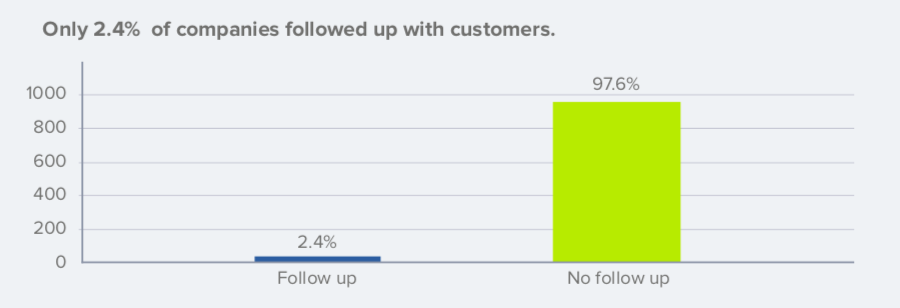When you’re able to reassess how you’re working and clean things up, you can set your customer support team up for an even better year serving your customers moving forward.
With the thawing of winter comes warmer weather and a new burst of energy to tackle projects, like spring cleaning. But why stop with organizing your life at home? Customer support team can apply the annual tradition to their work too.
Working on customer support team can often feel like there’s not much time for anything but responding to customer questions. When there are always new inquiries coming in, the idea of ignoring anyone for a little while to do some upkeep can seem daunting.
To get you started on how you can tackle spring cleaning for your customer support team this year, we’ve compiled nine ways to dive in.
Review Your Metrics
Take a look at the metrics you’re currently tracking. Are you happy with your CSAT results? Are your reply times in line with your team’s goals? Is the data you’re recording helpful? Is there something you’d like to track in more detail? Here’s your chance to figure it out and set it up. If you’re struggling to decide on which metrics to use, we’ve suggested some options here.
Geckoboard suggests growing teams must track these five customer support metrics:
- First Reply Time
- Ticket Volume
- Conversations per Teammate
- Customer Satisfaction
- Ticket Backlog
While it’s probably best to calculate these on a monthly basis, now’s your chance to get a handle on how these metrics are trending. Calculate each one, and look at historical data to see if everything is on track – or if you need to make changes, quickly.
Audit Your Support Docs
If your support team doesn’t have any dedicated people keeping your documentation current, now is a great time to do a full review. Examine every existing customer-facing document for accuracy and edit them as needed. Even if the text is correct, be sure to update any screenshots if the look of your product has changed since the last doc update. Next, consider if there are any you should delete or new ones to add.
Articles that receive very few visits can skew your SEO, and probably aren’t helpful to anyone. These least visited articles are called the “long-tail”. Consider deleting them, or condensing them into another article that’s relevant and easier to find.

You can find new articles to add by looking at search terms that don’t return responses.
Taking on the task of fully updating every support doc doesn’t necessarily have to happen right away, but coming up with a list is a solid start to mapping out a plan for a full update over the next few months.
Update Your Macros and Predefined responses
Now that you’ve taken a look at your user-facing documentation, check out the internal documents too. Does your customer support team use macros in Zendesk or share snippets in TextExpander? Take a look at the messages there and make sure they’re up-to-date too. Check for accuracy, of course, but also look at tone and style to make sure these align with your team’s current goals.
Ask Your Customers for Feedback
Does your organization currently request real-time customer feedback? If not, why not? According to SuperOffice’s Customer Service Benchmark Report, which analyzed the customer service quality of 1,000 companies around the world, 97% of companies don’t even send a follow-up email to customers to find out if they’re satisfied with the response they received, much less solicit feedback in real-time.

Make sure your customer support team knows what your customers think: ask them. In addition to real-time feedback, consider sending out a survey to a specific group of users, such as people who recently canceled their subscription or people who are very active using your product to check-in with them when they haven’t opened a support ticket. Consider asking their thoughts on how easy it is to reach your support team when needed, or if they find your self-service help area useful.
However you choose to collect your feedback, make sure you also take the time to read it. Reviewing feedback shouldn’t only fall to the customer service representative it’s aimed at. But it should also be monitored by the people steering customer support team and making decisions at a higher level. Understanding what your customers think about your service, good and bad, is essential at every level.
Triage Every Single Bug Report
You know that bug that was reported last year and keeps getting passed over? It might be fixable if only someone took the time to look at it. Make sure the right people know about old, outstanding bugs and work to get them fixed. Go through every open bug report and update, close, or fix. Make a plan to regularly triage any open bug reports in the future at regular intervals.
You might even find that a bug was fixed “accidentally” by a different update – and your customer hasn’t been informed!
Assess Your Tools
Consider the different methods of support you offer. Are the tools you use to power each of those working for your current team? Are your customers happy with the types of support you offer? Conduit’s Tech Edition of the State of Customer Experience 2017 report identified three types of users, and they each prefer different kinds of support.
According to the report, 24% of people prefer a DIY solution using self-help and virtual assistants, while 27% like to engage and prefer email, chat, and social media. The remaining 49% of people surveyed prefer an even more direct approach and will call support or seek help in person, if possible. While you may not have any plans to set up a storefront anytime soon (or ever), keep this breakdown of customer preferences in mind as you assess your tools and work to improve customer happiness.
Here are a few things to consider as you assess your tools:
- Are your support docs searchable and easy for your customers to access?
- Does your current help desk tool have the features your team needs?
- Do the kinds of support you offer align well with your goals and capabilities?
- Is there a type of support, like live chat or a concierge service, you should consider adding in the coming year?
Review Personal Development Goals
Make a plan to do something that will make you better at your job before the end of the year. Even better, ask everyone on your team to do this. Whether attending a workshop, practicing a new skill regularly, or learning new organizational techniques, everyone has something they can do to be better, if they are allowed the time and space to identify these areas and take them on.
Create your own customer support training program by identifying gaps in your skills. If you manage a team, make a note to check in during 1 on 1s to ensure everyone feels challenged. Make a commitment to learning in 2022.
Do a Security Check
Take a look at the access your employees have to company accounts. Remove old accounts that are no longer needed, and make sure every administrator account is one that needs to exist. If you find people with accounts who you no longer employ, add this task to your checklist to deal with as soon as they leave in the future. On the other hand, if you tend to restrict access and it causes delays or issues, try identifying people on your team who you can grant more access to so that your support team functions better 24/7. Also, make sure your team is up-to-date on security best practices.
Review Your Onboarding and Training Process for New Hires
Have you hired anyone new in customer support in the past year? How did their onboarding and training go? If you’re not sure, ask them for feedback and make changes, as needed. Often, the best person to help in this area is the one who went through the process not too long ago and has had a few months to settle in and understand the job.
Take Note and Plan for Next Year
Once you’ve made it through a round of spring cleaning for your support team in 2022, why not make it an annual tradition? Document your progress this year and use it as a guide to set yourself up for even greater success next year.











